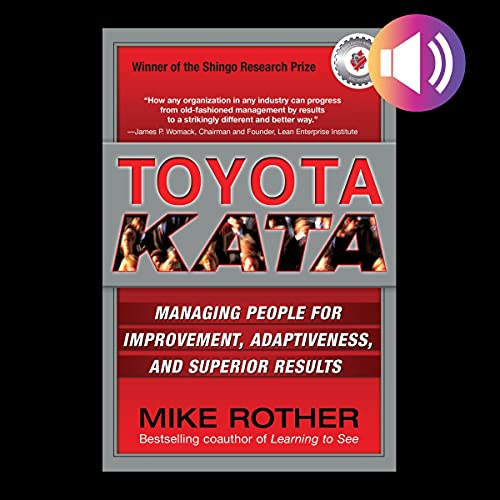Mike Rother’s “Toyota Kata” audiobook explores the continuous improvement and coaching methods used by Toyota. It focuses on developing scientific thinking and systematic problem-solving.
Toyota Kata delves into the practices that have made Toyota a leader in manufacturing and innovation. Mike Rother explains how the company’s approach can be applied to various industries. The audiobook covers essential topics like the Improvement Kata and Coaching Kata.
These methodologies emphasize the importance of a structured approach to problem-solving and continuous improvement. Listeners learn how to foster a culture of continuous learning and adaptability. The book is ideal for managers, leaders, and anyone interested in operational excellence. By integrating these practices, organizations can achieve sustained success and adaptability.
Introduction To Toyota Kata
The Toyota Kata audiobook by Mike Rother offers insights into Toyota’s success. It introduces listeners to Toyota’s unique approach to management and improvement. This method is known as Kata, a term borrowed from martial arts.
The Genesis Of Toyota’s Success
Toyota’s success story began in the mid-20th century. The company’s innovative production techniques set it apart from competitors. They focused on continuous improvement and efficient processes.
Key elements of Toyota’s approach include:
- Lean Manufacturing
- Just-In-Time Production
- Quality Control
The aim was to eliminate waste and optimize production. This led to higher quality and lower costs. Toyota’s methods soon became a benchmark in the industry.
Mike Rother’s Journey
Mike Rother is a researcher and author. His journey with Toyota Kata started with a deep dive into Toyota’s methods. He wanted to understand the principles behind their success.
Rother’s research focused on the daily routines and practices at Toyota. He discovered the importance of structured routines in achieving continuous improvement.
Rother then shared these insights through his book and audiobook. The Toyota Kata Audiobook makes these concepts accessible to a wider audience. Listeners can learn about Toyota’s methods and apply them to their own work.
Rother’s work emphasizes two main routines:
- Improvement Kata – A systematic approach to problem-solving
- Coaching Kata – A method for teaching and reinforcing the Improvement Kata
By following these routines, organizations can foster a culture of continuous improvement. This leads to sustained success and innovation.

Credit: www.audible.com
Core Concepts Of Toyota Kata
Mike Rother’s Toyota Kata Audiobook is a transformative guide. It introduces readers to the core concepts of Toyota Kata. These principles help organizations continuously improve and innovate. Let’s delve into these core concepts.
Improvement Kata
The Improvement Kata focuses on achieving continuous improvement. It involves a four-step routine:
- Setting a direction or challenge
- Grasping the current condition
- Establishing the next target condition
- Moving toward that target condition
This routine helps teams set clear goals. It also helps in finding effective solutions. The Improvement Kata encourages small, incremental changes. These changes lead to significant improvements over time.
Coaching Kata
The Coaching Kata is about teaching and mentoring. It helps leaders coach their teams effectively. This Kata involves regular practice and feedback. The goal is to develop problem-solving skills within teams.
The Coaching Kata follows a structured approach:
- Observation of the learner’s current condition
- Providing guidance and support
- Ensuring the learner follows the Improvement Kata
- Regularly checking the learner’s progress
Coaching Kata helps create a culture of continuous learning. Leaders become better coaches. Teams become more capable problem solvers.
Implementing Toyota Kata In Your Organization
Mike Rother’s Toyota Kata audiobook provides a clear roadmap for continuous improvement. Implementing Toyota Kata can transform your organization’s work culture. It promotes a mindset of continuous learning and problem-solving. Here’s a guide to get you started.
Steps To Get Started
Follow these steps to implement Toyota Kata in your organization:
- Understand the Kata: Listen to the Toyota Kata audiobook. Learn about the Improvement Kata and Coaching Kata.
- Set a Vision: Define a clear long-term goal for your organization.
- Grasp the Current Condition: Analyze where your organization stands now. Identify gaps and challenges.
- Establish Target Conditions: Set short-term, achievable goals. These should lead you towards your long-term vision.
- Experiment and Learn: Conduct daily or weekly experiments. Use the Plan-Do-Check-Act (PDCA) cycle.
- Coach and Develop: Train leaders to be effective coaches. Use the Coaching Kata to guide teams.
Challenges And Solutions
Implementing Toyota Kata can face several challenges. Here are some common ones and their solutions:
| Challenge | Solution |
|---|---|
| Resistance to Change | Communicate the benefits clearly. Involve everyone in the process. |
| Lack of Skills | Provide training and resources. Use the Toyota Kata audiobook as a guide. |
| Time Constraints | Integrate Kata practices into daily routines. Start with small steps. |
| Maintaining Momentum | Set regular review sessions. Celebrate small wins to keep motivation high. |
Implementing Toyota Kata requires dedication and persistence. With the right approach, your organization can achieve continuous improvement and success.

Credit: www.youtube.com

Credit: www.youtube.com
Conclusion
Mike Rother’s Toyota Kata Audiobook offers valuable insights into continuous improvement. It’s a must-listen for anyone in business or management. Simplify complex processes and achieve excellence. Embrace the Toyota Kata method to boost productivity. Get started with this audiobook and transform your approach today.



